Carbon Dioxide Capture under Low-Pressure Low-Temperature Conditions Using Shaped Recycled Fly Ash Particles
Abstract
:1. Introduction
2. CO2 Storage Methods
- ▪
- CO2 Quality: The quality of the gas will affect its overall properties including flow behavior, reactivity with other fluids and with solids such as rocks and cement, compressibility and phase behavior, and environmental impact. An example of this is flue gas which includes CO2 along with other gases, some of which can be environmentally damaging such as hydrogen sulfide and carbon monoxide. Depending on the quality of the CO2, different methods of storage should be eliminated.
- ▪
- CO2 Phase and Availability: The CO2 phase is a strong function of pressure and temperature. Normally, the CO2 will either be in liquid or gaseous phase until the pressure exceeds 1071 psi and 31 °C at which the phase will become supercritical. The phase is important since it impacts the properties of the CO2 including density, viscosity, and flow behavior. The availability of CO2 depends on the location of storage and the available CO2 capture technology.
- ▪
- Method Selectivity: Although many CO2 storage methods are available, each method has advantages and limitations. This depends on the mechanism of each method, interactions and materials, and technological requirements in the target implementation location.
- ▪
- Safety and Environment: The main criteria for CO2 storage applications methods are safety and environmental impact. Although many methods have been proposed, several of these methods lack long-term stability. This includes storage in underground reservoirs, or in other materials such as cement. It is imperative that the long-term stability of CO2 be tested before implementation of the storage method to avoid leakages over time.
- ▪
- Economic Feasibility: One of the drawbacks of many CO2 storage methods is the overall cost of application. This can cause several institutions to avoid venturing into CO2 storage operations. It is important to test the economic feasibility of the CO2 storage method before implementation.
3. Experimental Description
3.1. Experimental Material
- CO2: The CO2 was provided in a pressurized cylinder with an initial pressure of 1200 psi. The cylinder was connected to a pressure regulator.
- Helium: The helium was provided in a pressurized cylinder with an initial pressure of 2400 psi. The cylinder was connected to a pressure regulator and connected to the setup via high-pressure tubing.
- Fly Ash: The fly ash used was purchased from a cement factory as a light-grey power with small traces of metals and impurities.
- Heat Jacket: The heat jack was internally imbedded within the adsorption vessel with a maximum temperature of 70 °C.
- Pressure Transducers: The pressure transducers were allocated across the setup for pressure reading and logging.
3.2. Experimental Setup
3.3. Experimental Procedure
- The adsorption cell was disconnected from the setup and filled with fly ash. It was important to ensure that the cell was well packed to avoid disturbance of the infrared readings during the experiment. Packing of the cell was conducted in a manner that would also leave space for the temperature thermocouples in order to record the temperature at different locations in the cell.
- The cell was then sealed and reconnected to the setup. Sealing of the cell was performed using metal bolts and a rubber seal to avoid leakage during the experiments. The valves were maintained closed until the experiment was ready.
- For experiments conducted at temperatures above room temperature (25 °C), the temperature regulator was adjusted to the design temperature and left for 12 h, or overnight, to ensure that the temperature was constant across the setup. The temperature was monitored using four thermocouples allocated across the setup.
- The CO2 was then injected into the setup at a design flowrate and the experiment began. Once the adsorption percentage stabilized, desorption occurred using helium. CO2 and helium were connected to the setup via high-pressure tubing, each with its own pathway to avoid gas crossflow.
- The experiment was concluded when the CO2 adsorption percentage reached zero. The adsorption cell was completely evacuated and then disconnected and opened to replace the fly ash sample.
3.4. Fly Ash Cube Synthesis
4. Results and Analysis
4.1. CO2 Injection Rate
4.2. Helium Injection Rate
4.3. Fly Ash Temperature
4.4. Contact Surface Area between Fly Ash and CO2
5. Discussion
6. Feasibility and Scalability of Fly-Ash-Based CO2 Capture
- ▪
- Compositional Variation in Fly Ash: Different fly ash will have different compositions depending on its origin. Based on this, the properties of the ash will vary, thus impacting the ability of the ash to adsorb CO2. This will, in turn, impact the CO2 capture capacity and capability of the fly ash.
- ▪
- Shaping of Fly Ash Particles: In order to shape the fly ash particle, geopolymerization is required. This involves an alkaline activator and water. The addition of these chemicals may impact the ability of the ash to adsorb CO2. Also, since different alkaline activators can be used, it is important to assess the impact of each separately.
- ▪
- Interaction with Water: Since fly ash is a pozzolanic material, it reacts with water to form a solid. This reaction impacts the available sites for adsorption on the surface of the ash, and thus impacts the overall CO2 adsorption capacity.
- ▪
- Selective Adsorption: One of the key points for any material that is used for CO2 adsorption is its ability to selectively adsorb CO2 in the presence of other gases. This requires extensive study due to the variable nature of fly ash and the chemicals used to treat it.
7. Limitations and Future Research Directions
8. Conclusions
- Increasing the CO2 injection rate resulted in an increase in the adsorption capacity of the gas to the fly ash. The increase increased more than three-fold when comparing the lowest to the highest injection rates.
- Increasing the temperature caused the fly ash to expand which resulted in an increase in the available adsorption sites. This in turn resulted in an increase in the CO2 adsorption capacity.
- Decreasing the helium injection rate not only impacted the desorption, but also the adsorption capacity. At lower helium injection rates, the desorption process was extremely lengthy, while the adsorption capacity decreased significantly.
- Doubling the contact surface area between the CO2 and the fly ash resulted in an increase in the CO2 adsorption capacity by more than three times, which indicated the significance of this factor on the overall CO2 storage capacity.
Author Contributions
Funding
Data Availability Statement
Acknowledgments
Conflicts of Interest
References
- Zhang, L.; Zhou, F.; Mou, J.; Feng, W.; Li, Z.; Zhang, S. An Integrated Experimental Method to Investigate Tool-Less Temporary-Plugging Multistage Acid Fracturing of Horizontal Well by Using Self-Degradable Diverters. SPE J. 2020, 25, 1204–1219. [Google Scholar] [CrossRef]
- Copeland, C.; McAuley, J. Controlling Sand with an Epoxy-Coated, High-Solids-Content Gravel Slurry. J. Pet. Technol. 1974, 26, 1215–1220. [Google Scholar] [CrossRef]
- Du, J.; Bu, Y.; Liu, H.; Shen, Z. Experimental Feasibility Study of a Novel Organic-Inorganic Hybrid Material for Offshore Oil Well Cementation. In Proceedings of the 28th International Ocean and Polar Engineering Conference, Sapporo, Japan, 10–15 June 2018. [Google Scholar]
- Huo, J.-H.; Peng, Z.-G.; Xu, K.; Feng, Q.; Xu, D.-Y. Novel micro-encapsulated phase change materials with low melting point slurry: Characterization and cementing application. Energy 2019, 186, 115920. [Google Scholar] [CrossRef]
- Fakher, S.; Fakher, A. Investigating the Use of CO2 as a Hydraulic Fracturing Fluid for Water Sustainability and Environmental Friendliness. In Proceedings of the SPE/IATMI Asia Pacific Oil & Gas Conference and Exhibition, Virtual, 12–14 October 2021. [Google Scholar] [CrossRef]
- Fakher, S.; Khlaifat, A.L. Experimental Investigation of Polymer Injection in High Permeability Conduits for Material Sustainability and Behavior in Oil Reservoirs. Polymers 2023, 15, 2950. [Google Scholar] [CrossRef] [PubMed]
- Kosek, J.R.; DuPont, J.N.; Marder, A.R. Effect of Porosity on Resistance of Epoxy Coatings to Cold-Wall Blistering. Corrosion 1995, 51, 861–871. [Google Scholar] [CrossRef]
- Leggat, R.B.; Zhang, W.; Buchheit, R.G.; Taylor, S.R. Performance of Hydrotalcite Conversion Treatments on AA2024-T3 When Used in a Coating System. Corrosion 2002, 58, 322–328. [Google Scholar] [CrossRef]
- Leggett, S.; Reid, T.; Zhu, D.; Hill, A.D. Experimental Investigation of Low-Frequency Distributed Acoustic Strain-Rate Responses to Propagating Fractures. SPE J. 2022, 27, 3814–3828. [Google Scholar] [CrossRef]
- Liu, B.; Li, Y.; Lin, H.; Cao, C.-N. Electrochemical Impedance Spectroscopy Study on the Diffusion Behavior of Water through Epoxy Coatings. Corrosion 2003, 59, 817–820. [Google Scholar] [CrossRef]
- Fakher, S.; Al-Sakkaf, A.; Ali, M. Evaluating key parameters impacting asphaltene permeability reduction behavior in micro-pores during carbon dioxide injection. Fuel 2023, 339, 126933. [Google Scholar] [CrossRef]
- Fakher, S. Development of novel mathematical models for laboratory studies of hydrolyzed polyacrylamide polymer injectivity in high-permeability conduits. J. Pet. Explor. Prod. Technol. 2020, 10, 2035–2043. [Google Scholar] [CrossRef]
- Fakher, S. Investigating the Factors Impacting the Success of Immiscible Carbon Dioxide Injection in Unconventional Shale Reservoirs: An Experimental Study (Order No. 27832893). ProQuest Dissertations & Theses Global. (2430974849). 2020. Available online: https://login.libproxy.aucegypt.edu/login?url=https://www.proquest.com/dissertations-theses/investigating-factors-impacting-success/docview/2430974849/se-2 (accessed on 3 October 2023).
- Khlaifat, A.L.; Fakher, S.; Harrison, G.H. Evaluating Factors Impacting Polymer Flooding in Hydrocarbon Reservoirs: Laboratory and Field-Scale Applications. Polymers 2023, 16, 75. [Google Scholar] [CrossRef]
- Khlaifat, A.; Fakher, S.; Ibrahim, A.D.; Elsese, M.; Nour, A. High-salinity produced water treatment and desalination. LHB 2023, 109, 2284957. [Google Scholar] [CrossRef]
- Shaughnessy, C.; Salathiel, W.; Penberthy, W.J. A New, Low-Viscosity, Epoxy Sand-Consolidation Process. J. Pet. Technol. 1978, 30, 1805–1812. [Google Scholar] [CrossRef]
- Singh, D.D.N.; Ghosh, R. Unexpected Deterioration of Fusion-Bonded Epoxy-Coated Rebars Embedded in Chloride-Contaminated Concrete Environments. Corrosion 2005, 61, 815–829. [Google Scholar] [CrossRef]
- Spinks, G.M.; Dominis, A.J.; Wallace, G.G. Comparison of Emeraldine Salt, Emeraldine Base, and Epoxy Coatings for Corrosion Protection of Steel During Immersion in a Saline Solution. Corrosion 2003, 59, 22–31. [Google Scholar] [CrossRef]
- Fakher, S.; Elgahawy, Y.; Abdelaal, H.; Imqam, A. What are the Dominant Flow Regimes During Carbon Dioxide Propagation in Shale Reservoirs’ Matrix, Natural Fractures and Hydraulic Fractures? In Proceedings of the SPE Western Regional Meeting, Virtual, 20–22 April 2021. [Google Scholar] [CrossRef]
- Yao, Z.T.; Ji, X.S.; Sarker, P.K.; Tang, J.H.; Ge, L.Q.; Xia, M.S.; Xi, Y.Q. A comprehensive review on the applications of coal fly ash. Earth-Sci. Rev. 2015, 141, 105–121. [Google Scholar] [CrossRef]
- Prasad, B.; Mondal, K. Environmental impact of manganese due to its leaching from coal fly ash. J. Environ. Sci. Eng. 2009, 51, 27–32. [Google Scholar]
- Kikuchi, R. Application of coal ash to environmental improvement: Transformation into zeolite, potassium fertilizer, and FGD absorbent. Resour. Conserv. Recycl. 1999, 27, 333–346. [Google Scholar] [CrossRef]
- Sun, L.; Li, D.; Pu, W.; Li, L.; Bai, B.; Han, Q.; Zhang, Y.; Tang, X. Combining Preformed Particle Gel and Curable Resin-Coated Particles to Control Water Production from High-Temperature and High-Salinity Fractured Producers. SPE J. 2019, 25, 938–950. [Google Scholar] [CrossRef]
- Shafeeyan, M.S.; Daud, W.M.A.W.; Houshmand, A.; Shamiri, A. A review on surface modification of activated carbon for carbon dioxide adsorption. J. Anal. Appl. Pyrolysis 2010, 89, 143–151. [Google Scholar] [CrossRef]
- Reddy, M.S.B.; Ponnamma, D.; Sadasivuni, K.K.; Kumar, B.; Abdullah, A.M. Carbon dioxide adsorption based on porous materials. RSC Adv. 2021, 11, 12658–12681. [Google Scholar] [CrossRef]
- Baltrusaitis, J.; Schuttlefield, J.; Zeitler, E.; Grassian, V.H. Carbon dioxide adsorption on oxide nanoparticle surfaces. Chem. Eng. J. 2011, 170, 471–481. [Google Scholar] [CrossRef]
- Chiang, Y.-C.; Juang, R.-S. Surface modifications of carbonaceous materials for carbon dioxide adsorption: A review. J. Taiwan Inst. Chem. Eng. 2017, 71, 214–234. [Google Scholar] [CrossRef]
- Guo, B.; Chang, L.; Xie, K. Adsorption of Carbon Dioxide on Activated Carbon. J. Nat. Gas Chem. 2006, 15, 223–229. [Google Scholar] [CrossRef]
- Saha, B.B.; Jribi, S.; Koyama, S.; El-Sharkawy, I.I. Carbon Dioxide Adsorption Isotherms on Activated Carbons. J. Chem. Eng. Data 2011, 56, 1974–1981. [Google Scholar] [CrossRef]
- Bonenfant, D.; Kharoune, M.; Niquette, P.; Mimeault, M.; Hausler, R. Advances in principal factors influencing carbon dioxide adsorption on zeolites. Sci. Technol. Adv. Mater. 2008, 9, 013007. [Google Scholar] [CrossRef]
- Mishra, A.K.; Ramaprabhu, S. Carbon dioxide adsorption in graphene sheets. AIP Adv. 2011, 1, 032152. [Google Scholar] [CrossRef]
- Hinkov, I.; Lamari, F.; Langlois, P.; Dicko, M.; Chilev, C.; Pentchev, I. Carbon Dioxide Capture by Adsorption (review). J. Chem. Technol. Metall. (JCTM) 2016, 51, 609–626. [Google Scholar]
- Zhang, Z.; Schott, J.A.; Liu, M.; Chen, H.; Lu, X.; Sumpter, B.G.; Fu, J.; Dai, S. Prediction of Carbon Dioxide Adsorption via Deep Learning. Angew. Chem. 2018, 131, 265–269. [Google Scholar] [CrossRef]
- Shafeeyan, M.S.; Daud, W.M.A.W.; Shamiri, A. A review of mathematical modeling of fixed-bed columns for carbon dioxide adsorption. Chem. Eng. Res. Des. 2014, 92, 961–988. [Google Scholar] [CrossRef]
- Li, J.-R.; Ma, Y.; McCarthy, M.C.; Sculley, J.; Yu, J.; Jeong, H.-K.; Balbuena, P.B.; Zhou, H.-C. Carbon dioxide capture-related gas adsorption and separation in metal-organic frameworks. Coord. Chem. Rev. 2011, 255, 1791–1823. [Google Scholar] [CrossRef]
- Yong, Z.; Mata, V.; Rodrigues, A.E. Adsorption of carbon dioxide at high temperature—A review. Sep. Purif. Technol. 2002, 26, 195–205. [Google Scholar] [CrossRef]
- Hassanpouryouzband, A.; Yang, J.; Tohidi, B.; Chuvilin, E.M.; Istomin, V.; Bukhanov, B.A. Geological CO2 Capture and Storage with Flue Gas Hydrate Formation in Frozen and Unfrozen Sediments: Method Development, Real Time-Scale Kinetic Characteristics, Efficiency, and Clathrate Structural Transition. ACS Sustain. Chem. Eng. 2019, 7, 5338–5345. [Google Scholar] [CrossRef]
- Panchal, S.; Debasis, D. Composite Cemented Backfill Based on Fly Ash, Bottom Ash and Mill Tailings. In Proceedings of the ISRM International Symposium—10th Asian Rock Mechanics Symposium, Singapore, 29 October–3 November 2018. [Google Scholar]
- Tosun, Y.I. Stabilization of Slope with Use of Coal Boiler Bottom Ash, Fly Ash and Geosynthethics for Bottom Seal Layer for Municipal Waste Landfill. In Proceedings of the ISRM 1st International Conference on Advances in Rock Mechanics—TuniRock 2018, Hammamet, Tunisia, 29–31 March 2018. [Google Scholar]
- Nyakilla, E.E.; Jun, G.; Charles, G.; Ricky, E.X.; Hussain, W.; Iqbal, S.M.; Kalibwami, D.C.; Alareqi, A.G.; Shaame, M.; Ngata, M.R. Application of Group Method of Data Handling via a Modified Levenberg-Marquardt Algorithm in the Prediction of Compressive Strength of Oilwell Cement with Reinforced Fly Ash Based on Experimental Data. SPE Drill. Complet. 2023, 38, 452–468. [Google Scholar] [CrossRef]
- Krstic, M.; Božovic, N.; Ðokovic, K. Stabilization of loess with fly ash. In Proceedings of the 5th Symposium of the Macedonian Association for Geotechnics, Ohrid, North Macedonia, 23–25 June 2022. [Google Scholar]
- Adewunmi, A.A.; Kamal, M.S. Performance Evaluation of Fly Ash as a Potential Demulsifier for Water-in-Crude-Oil Emulsion Stabilized by Asphaltenes. SPE Prod. Oper. 2019, 34, 820–829. [Google Scholar] [CrossRef]
- Adjei, S.; Elkatatny, S.; Sarmah, P.; Chinea, G. Investigation of Dehydroxylated Sodium Bentonite as a Pozzolanic Extender in Oil-Well Cement. SPE Drill. Complet. 2021, 36, 730–737. [Google Scholar] [CrossRef]
- Cella, P.A.; Taylor, S.R. Electrical Resistance Changes as an Alternate Method for Monitoring the Corrosion of Steel in Concrete and Mortar. Corrosion 2000, 56, 951–959. [Google Scholar] [CrossRef]
- Montemor, M.F.; Simões, A.M.P.; Ferreira, M.G.S. Analytical Characterization of the Passive Film Formed on Steel in Solutions Simulating the Concrete Interstitial Electrolyte. Corrosion 1998, 54, 347–353. [Google Scholar] [CrossRef]
- Cunningham, W.; Fehrenbach, J.; Maier, L. Arctic Cements and Cementing. J. Can. Pet. Technol. 1972, 11, PETSOC-72-04-06. [Google Scholar] [CrossRef]
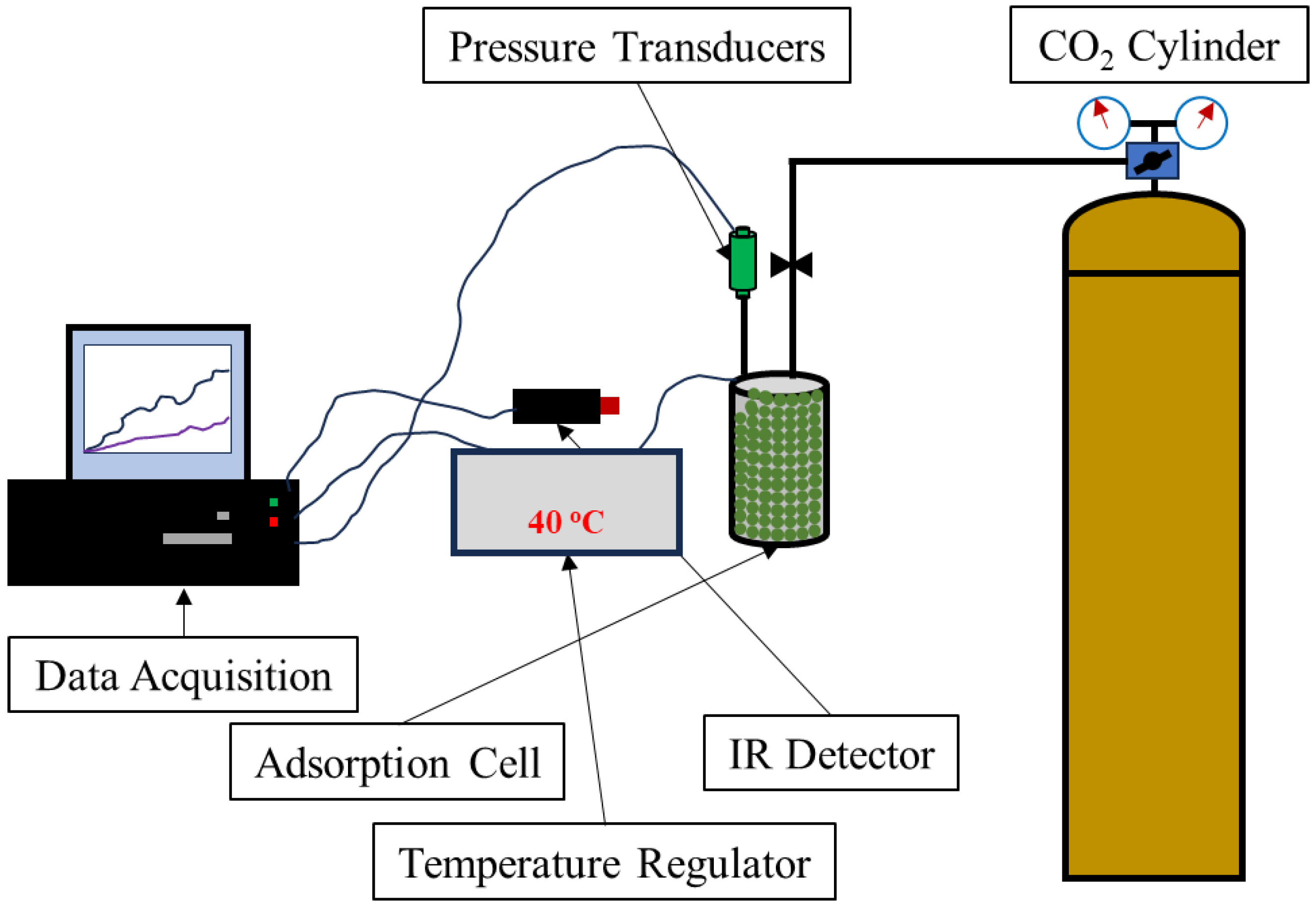
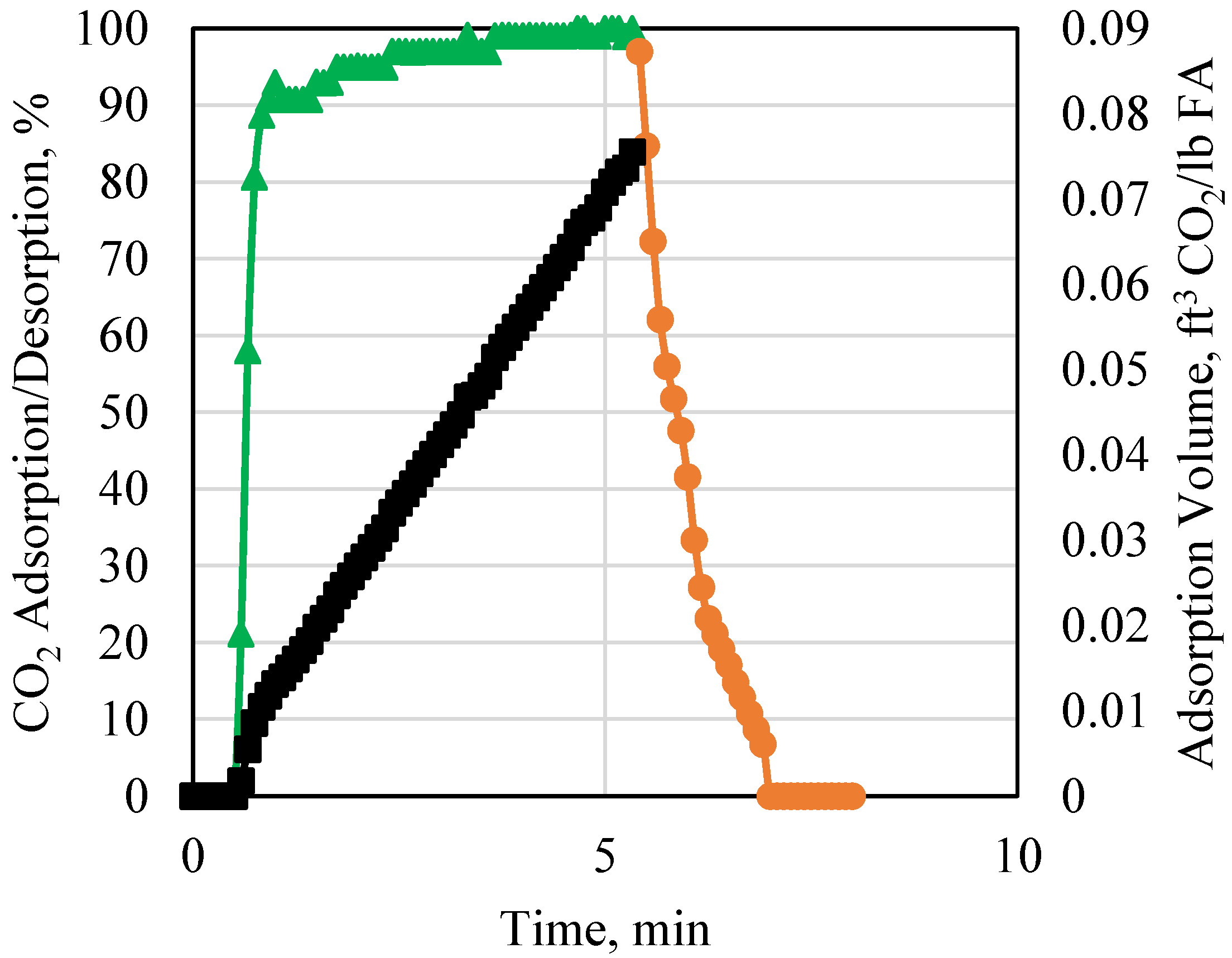

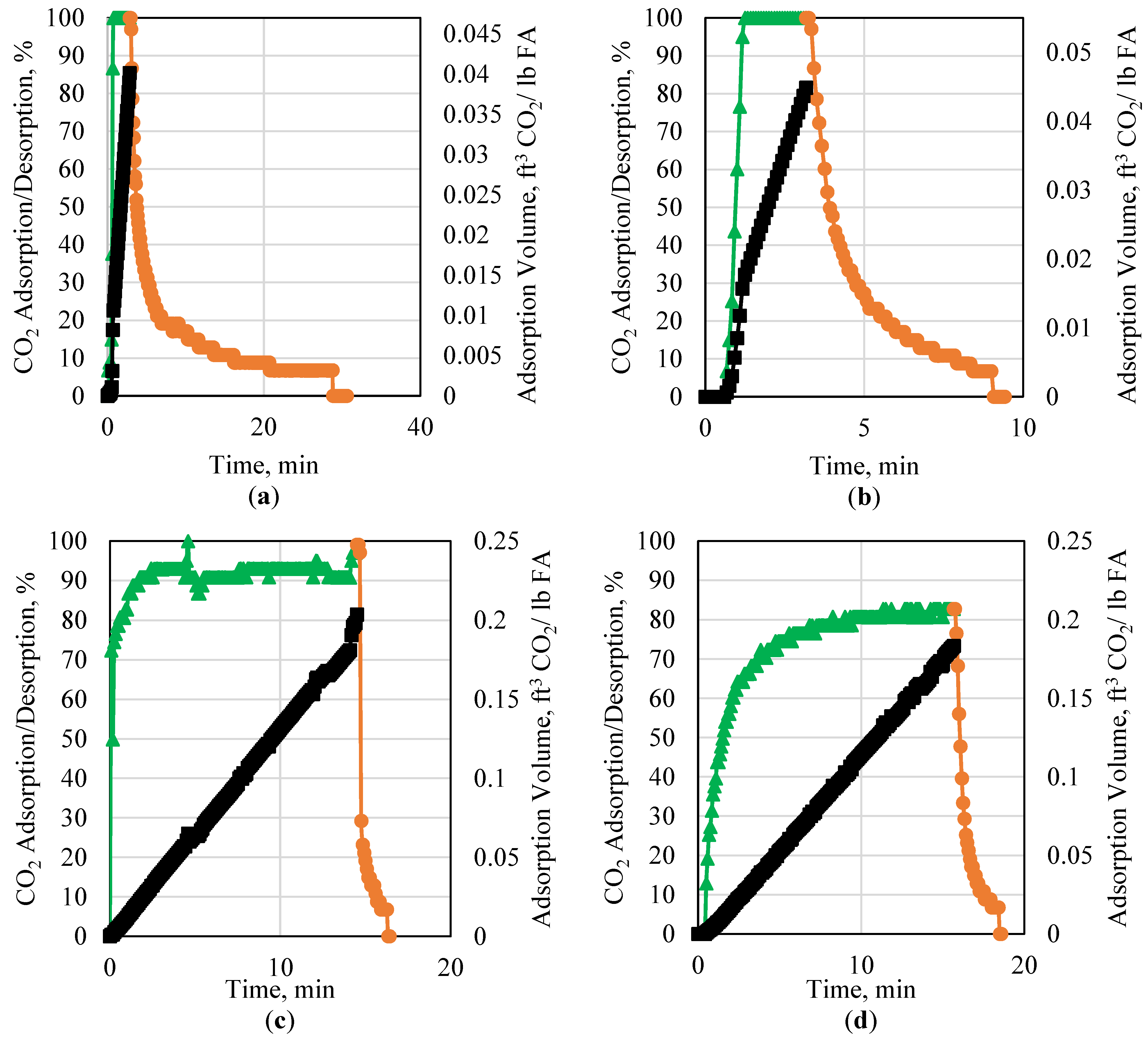


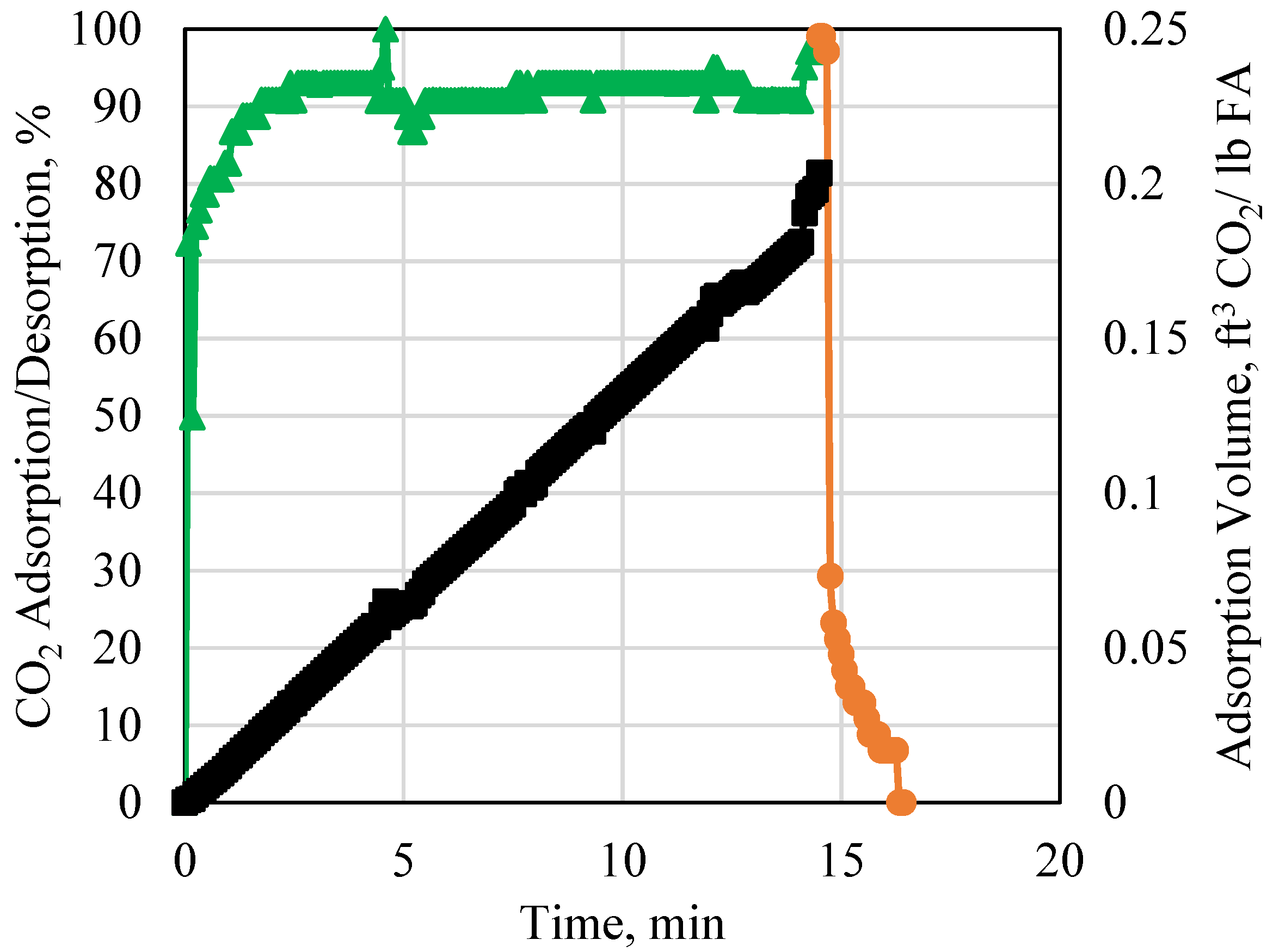
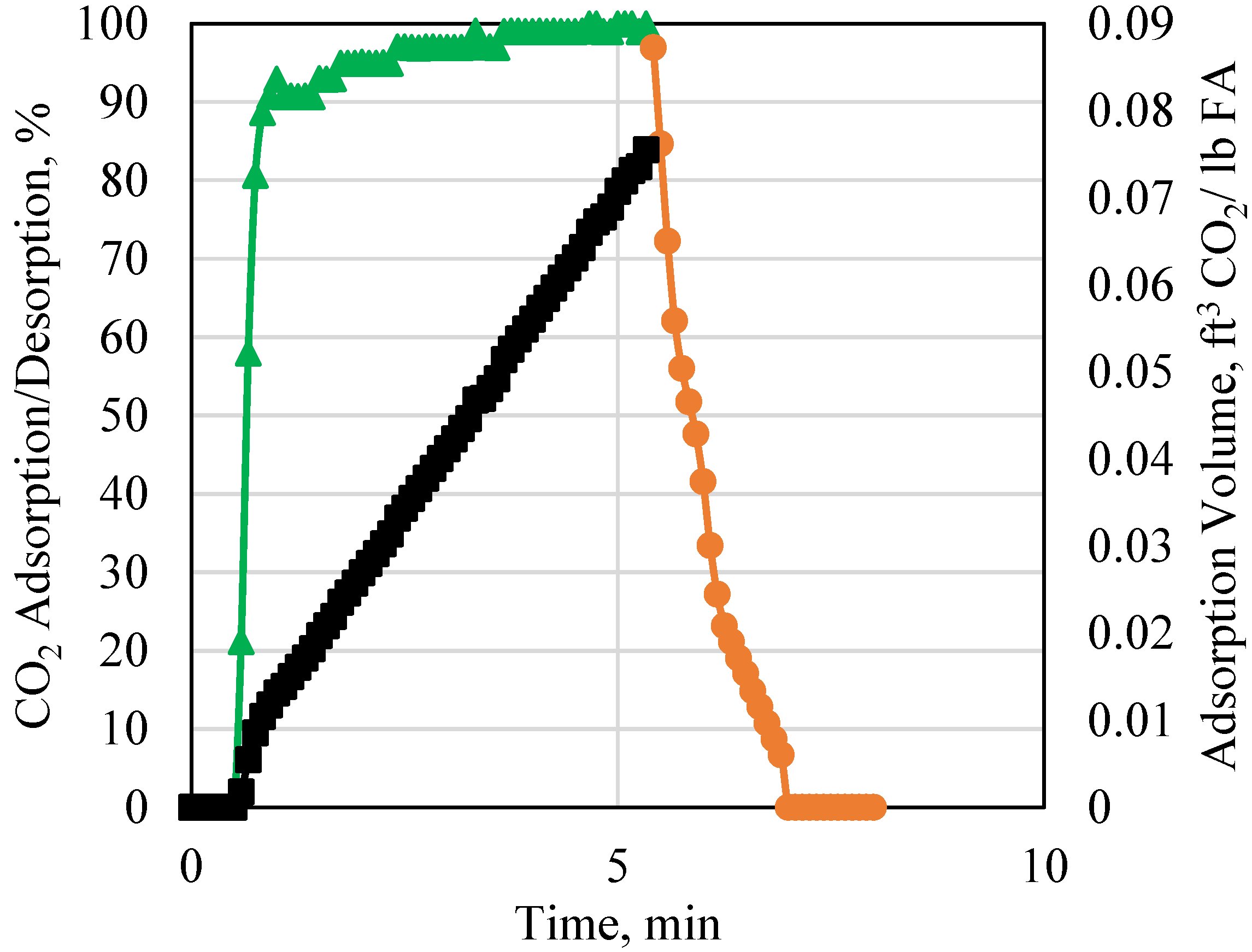
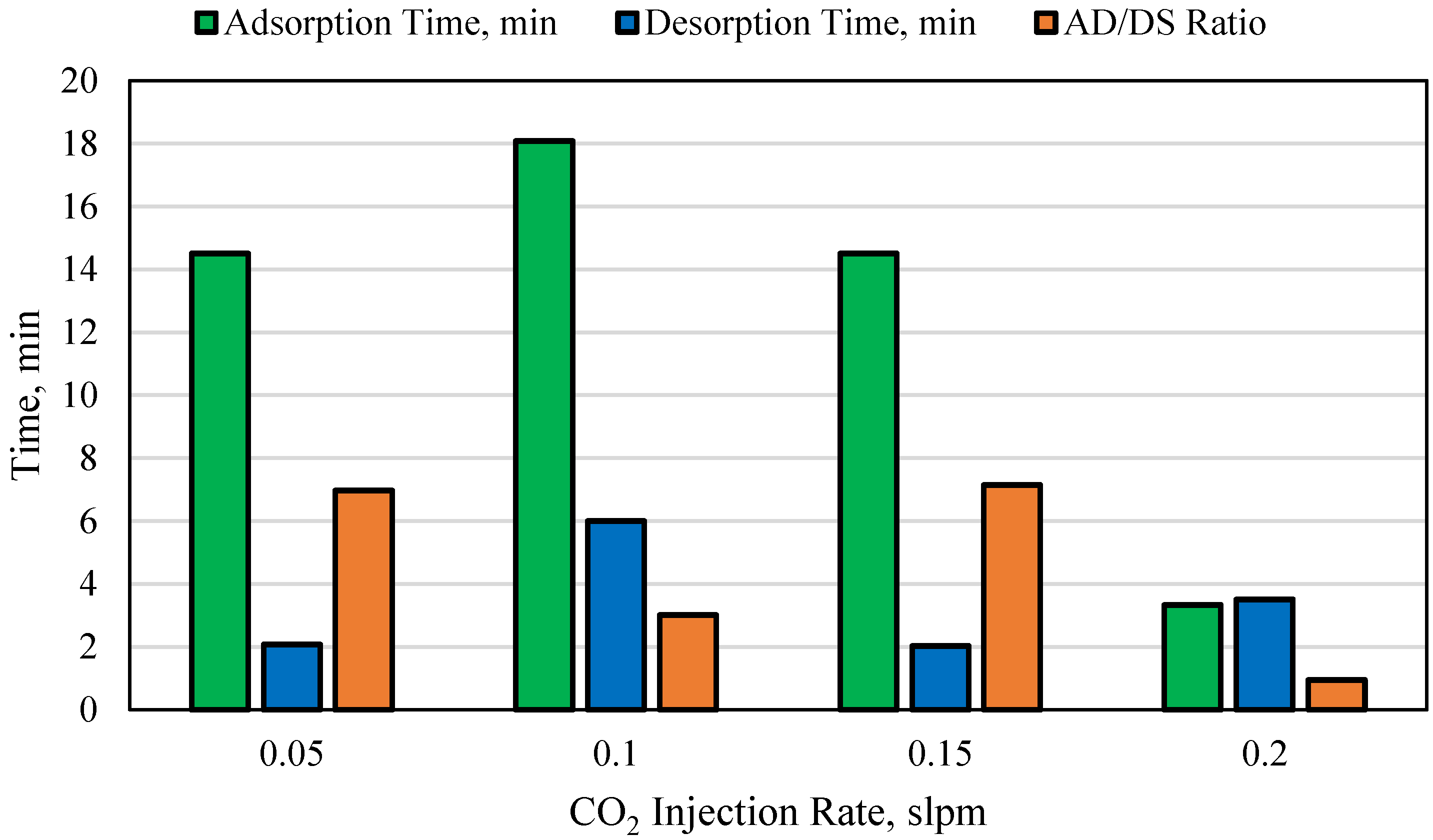
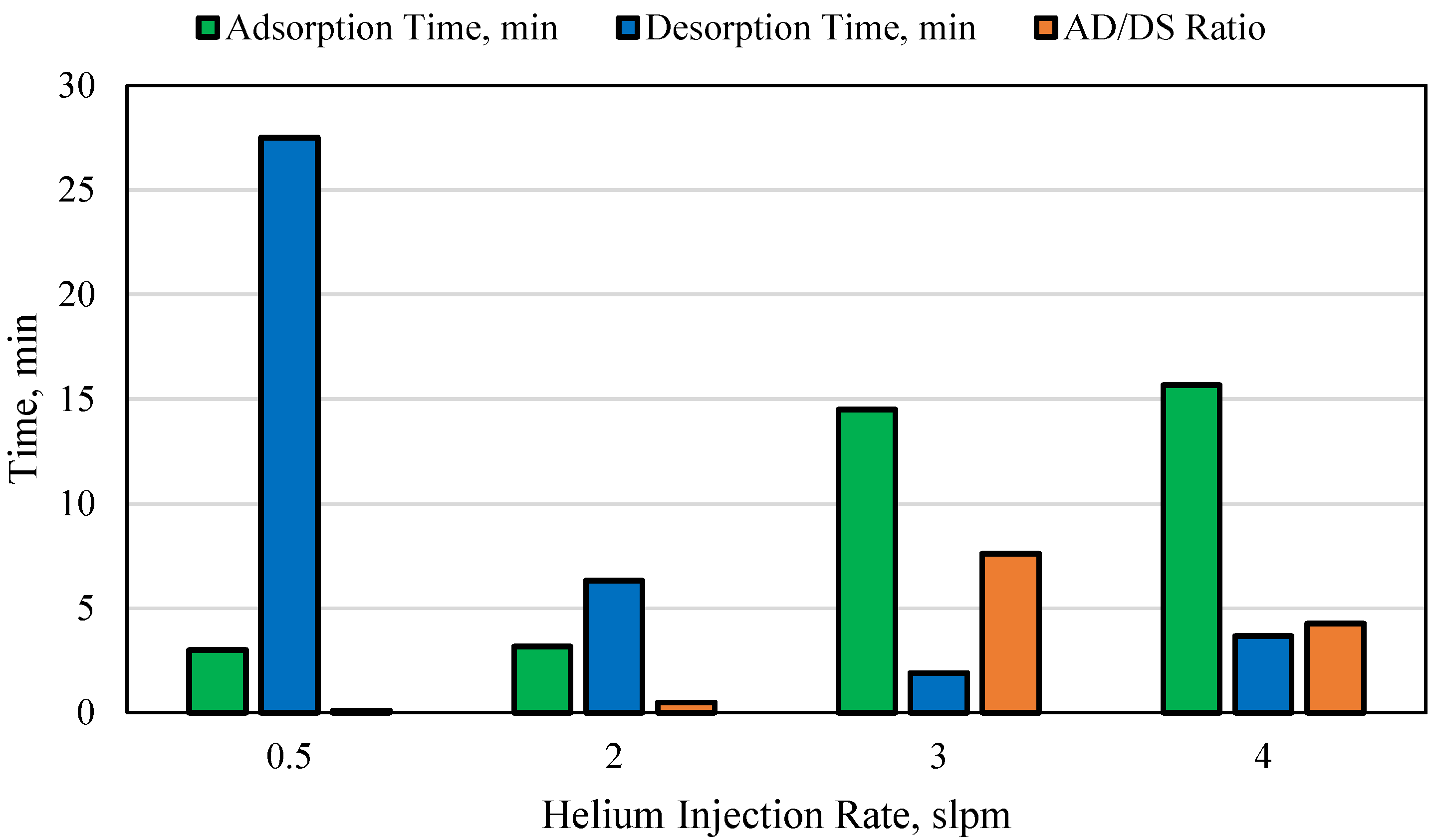
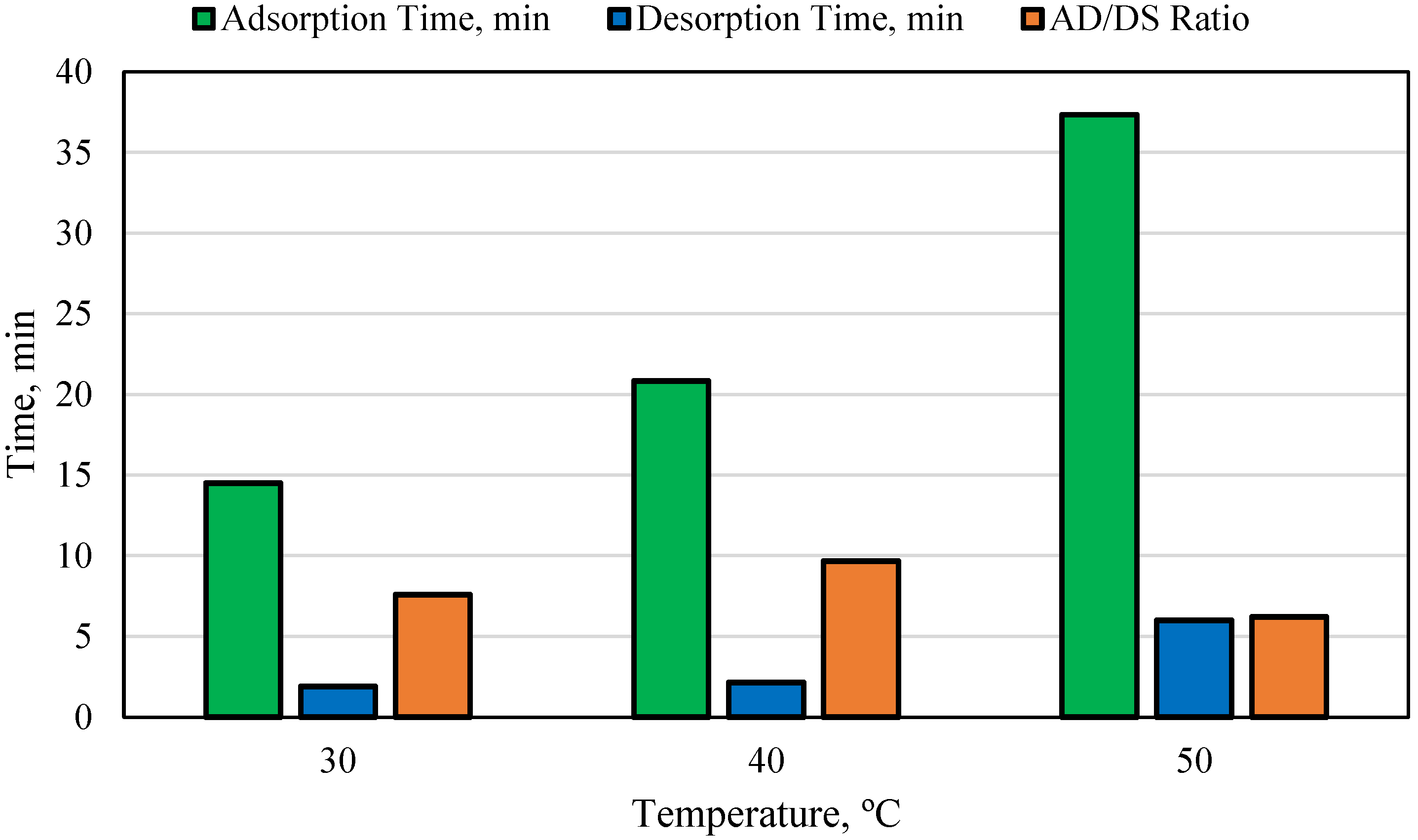
Disclaimer/Publisher’s Note: The statements, opinions and data contained in all publications are solely those of the individual author(s) and contributor(s) and not of MDPI and/or the editor(s). MDPI and/or the editor(s) disclaim responsibility for any injury to people or property resulting from any ideas, methods, instructions or products referred to in the content. |
© 2024 by the authors. Licensee MDPI, Basel, Switzerland. This article is an open access article distributed under the terms and conditions of the Creative Commons Attribution (CC BY) license (https://creativecommons.org/licenses/by/4.0/).
Share and Cite
Fakher, S.; Khlaifat, A.; Hassanien, A. Carbon Dioxide Capture under Low-Pressure Low-Temperature Conditions Using Shaped Recycled Fly Ash Particles. Gases 2024, 4, 117-132. https://doi.org/10.3390/gases4020007
Fakher S, Khlaifat A, Hassanien A. Carbon Dioxide Capture under Low-Pressure Low-Temperature Conditions Using Shaped Recycled Fly Ash Particles. Gases. 2024; 4(2):117-132. https://doi.org/10.3390/gases4020007
Chicago/Turabian StyleFakher, Sherif, Abdelaziz Khlaifat, and Abdullah Hassanien. 2024. "Carbon Dioxide Capture under Low-Pressure Low-Temperature Conditions Using Shaped Recycled Fly Ash Particles" Gases 4, no. 2: 117-132. https://doi.org/10.3390/gases4020007





